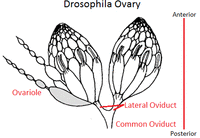An ovariole is one of the tubes of which the ovaries of most insects are composed.[1] Typically an insect will have two ovaries. The constituent ovarioles lead to two oviducts, which converge into a single oviduct. The ovarioles are composed of a germarium and a set of ovarial follicles.
In D. melanogaster
In Drosophila melanogaster, there are 16 ovarioles per ovary and there are two ovaries. The most anterior portion of the ovariole consist of the germarium, the location of germ line stem cells (GSCs), terminal filaments, cap cells and intergermarial sheath cells. The GSCs are what later on give rise to eggs. There are 14 distinct stages in the development of oocyte, and the progression in development occurs anterior to posterior along the ovariole. At the end of stage 14, the egg passes through the lateral oviduct before entering the common oviduct and then exiting via the uterus.
References
- ^ King, Robert C.; Mulligan, Pamela K.; Stansfield, William D. (2013). A dictionary of genetics (8th ed.). Oxford University Press. doi:10.1093/acref/9780199766444.001.0001. ISBN 9780199376865.
![]() This article incorporates text from a publication now in the public domain: Porter, Noah, ed. (1913). Webster's Dictionary. Springfield, Massachusetts: C. & G. Merriam Co.
This article incorporates text from a publication now in the public domain: Porter, Noah, ed. (1913). Webster's Dictionary. Springfield, Massachusetts: C. & G. Merriam Co.
